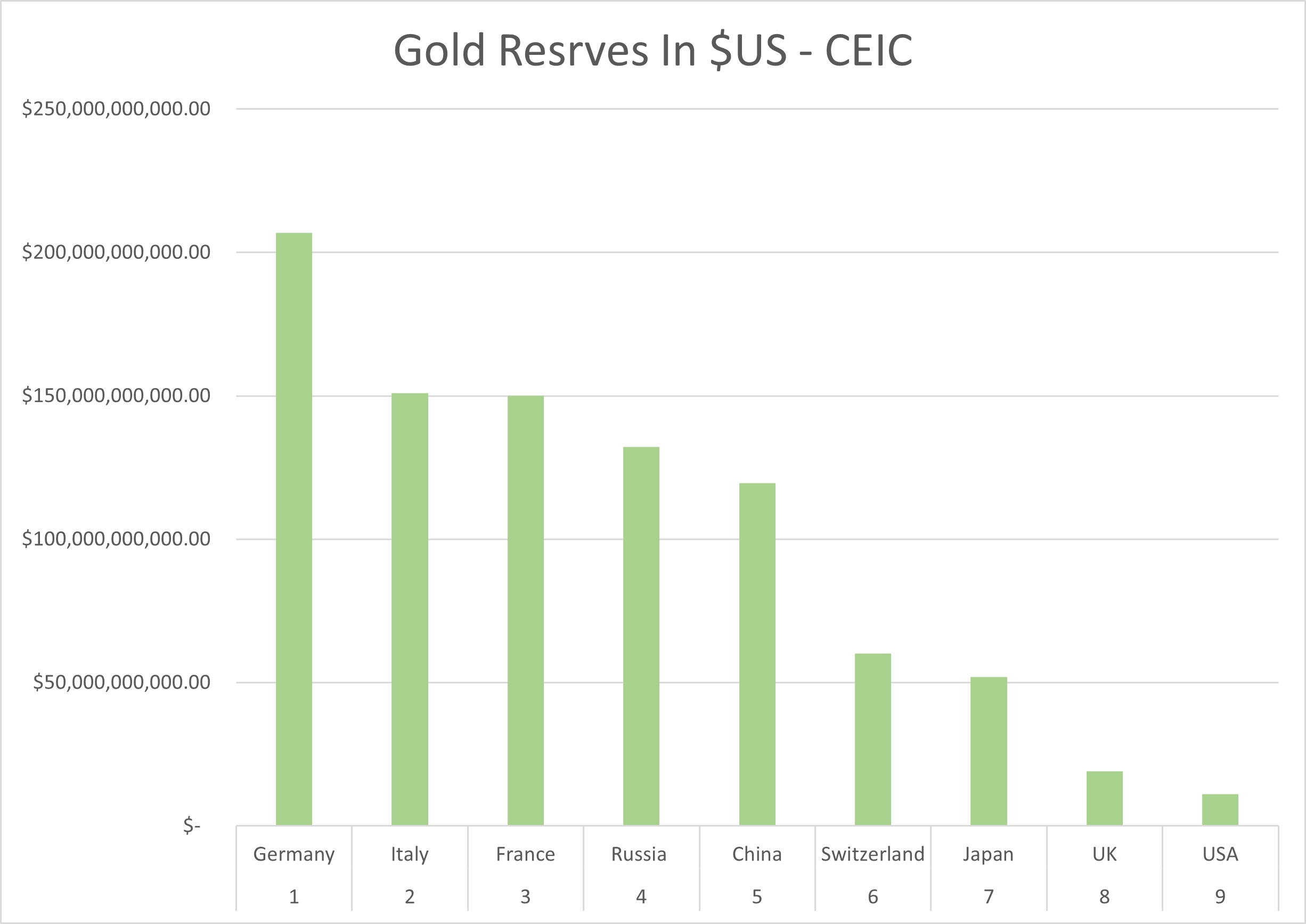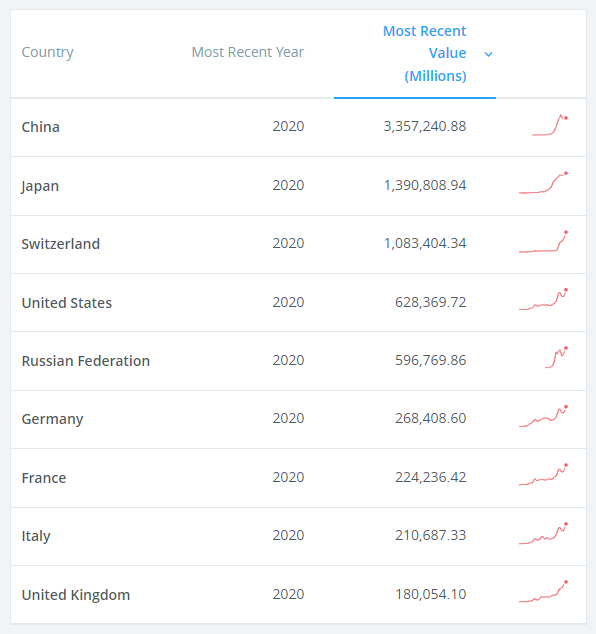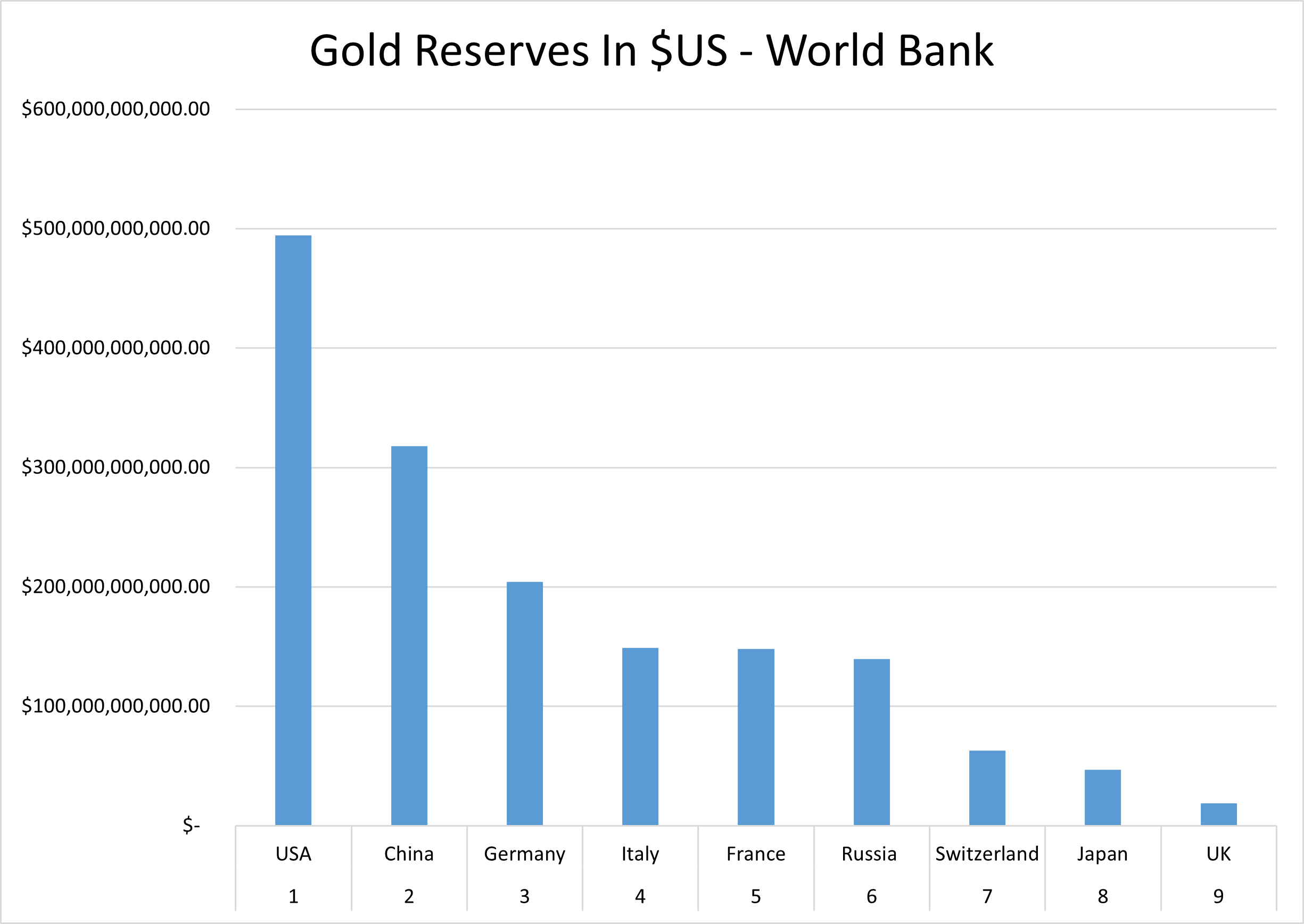Gold Reserves by Country (2022): An Unbiased Ranking and Review
Disclosure: We are reader-supported. If you purchase from a link on our site, we may earn a commission. Learn more
We’ve accessed various accredited, verified, and recent data sources in order to provide the most accurate rankings possible of countries in order of gold held by the central government.
Fair warning, however, that many reputable sources do not coincide with each other. For instance, Chinese sources conflict heavily with Western-origin sources. This creates a dilemma, which sources have the right numbers? And to what extent can the numbers reported by central authorities be relied upon?
We have examined three central resources and realized that creating a conclusive ranking based on the information found was not entirely possible. Nonetheless we’ve put together an exclusive ranking to the best of our ability based on the information available.
However, we did proceed with information from highly reputed global institutions that access their information regularly. These data providers are well regarded by economists, investment professionals, and industry experts alike.
Table of Contents
Rankings & Sources
To compose our rankings, we’ve put together a composite of three trusted data sources held by three globally recognized institutions:
The list includes G7 countries, plus Russia and China. Canada is missing from the list as it has no formal gold reserves. China and Russia have been included for the size of their economies, their geopolitical importance, and the value of their gold reserves.
Ranking According to The World Gold Council
World Gold Council ranks by tonnes of gold, to make a more easily comparable ranking criterion, we calculated the equivalent troy ounces and multiplied that number by the current spot price. We now have a ranking from The World Gold Council based on the US dollar worth of reserves.

Source: World Gold Council
The chart above shows country gold reserves ranked in US dollars. While the chart below shows country gold reserves ranked by tonnes. Both sets of data are from The World Gold Council.

Source: World Gold Council
Ranking according to CEIC
CEIC was founded in 1992 by an expert team of analysts and economists to provide accurate and expansive data services. Among their clients you'll find Universities, corporations, and investors among others.
They are a recognized and precise data provider that has staff operating in 18 different countries. We find their data reliable. Having said that, CEIC is the only one of the 3 sources that put the United States at the bottom of the list we created for gold reserves.
Their data shows gold reserves for the US at just over $11 billion, clearly, that number is a mistake. However, we are confident about the rest of the data, which is in line with the other 2 data providers. The CEIC estimates China holds over $119 billion, ranking them 5th.

Source: CEIC
Ranking According to The World Bank
The data from The World Bank ranks country reserves including gold and excluding gold. We then subtracted the data for reserves excluding gold from the data for reserves including gold. The subtraction gives us the value of gold holdings in US dollars per country.
Reserves Including Gold per Country

Source: World Bank
Reserves Excluding Gold Per Country

Source: World Bank
The chart below shows the ranking for gold reserves per country from the World Bank using the method mentioned above. The World Bank ranks the USA first with just short of $500 billion in gold, and China second with $318 billion in gold reserves.

Source: World Bank
Data Comparison
We have found that all three sources rank our list of countries for gold reserves in more or less the same way, excluding CEIC with the United States. The chart below shows a graphical comparison of the countries ranked and the list produced by each of the three data sources.

As we can see from the chart above, China ranks 6th with the World Gold council but 2nd with both the CEIC and the World Bank. Estimates made by the China Gold Association (CGA) would effectively put China at the top of the ranking. The CGA estimates China holds over 14,700 tonnes of gold in reserves.
That number far exceeds any of the two estimates from the CEIC or the World Bank, and frankly leaves the World Gold Council completely off the mark. Given the difficulty of retrieving reliable information from China, it is not possible to make a conclusive estimate of China's gold reserves.
However, we know from various reports from Chinese media that the government has increased the reserve holding of gold for at least a decade, and continues to do so as of August 2022. This fact should put China closer to the top of the list and could possibly be the reason for which reports from the CGA are likely to be more in line with real figures.
For a recent examination of China’s gold acquisition campaign, check out our article on Xi Jinping’s efforts to shore up the People’s Republic’s position in the yellow metal. It could be the case that Xi has acquired as much as 30,000 metric tons of gold according to Chinese sources.
What the Experts Say
Some experts are particularly interested in gold being amassed by the People’s Republic of China. Keith Weiner, a PhD, economist, and CEO of Monetary Metals, has the following to say:
“Foreign central banks hold dollars as assets on their balance sheet, and their local currencies are the liabilities. They are dismayed, when the dollar drops, because it means capital losses to them. Gold is a counterbalance, it may go up in local currency terms when the dollar is going down.
Also, Putin expected economic sanctions when he planned [the invasion of] Ukraine. So he accumulated gold. Xi may be thinking of a similar move. Gold is not subject to the same kind of control as US dollars are. Though as Putin is discovering, it can be hard to sell gold, too, when under sanctions.”
Likewise, some analysts, such as Alasdair Macleod, the Executive Chairman of Macdoch Group, a London-based private investment firm, believe that China is hoarding far more gold than conventional Western sources let on. Alasdair says the following in reference to China.
“They’ve got a lot of hidden reserves…They aren’t in the central bank’s account, but the Communist Party’s accounts, the army accounts, and the Young Communist Party’s accounts—it’s kind of spread around…I suspect Russia is in a similar situation.”
In an effort to de-dollarize, China is alleged to have purchased large amounts of gold that do not appear on official ledgers such as those of the IMF or World Bank. Rather, they are alleged to keep the gold off the books because to reveal the extent of their holdings would destabilize the value of the U.S. dollar, a currency China holds in reserve to the tune of $3.2 trillion.
Our Conclusion
Needless to say, it’s impossible to know with any degree of certainty how much gold is held by every country in the world. However, there are credible accounts that indicate that either the United States or China holds, by large margins, the most in the world.
According to expert testimony and recent large-scale gold reserve acquisitions by China, our best approximation of the current global situation regarding gold reserves is as follows:
- China (14,000-30,000 metric tons)
- United States (8,100 metric tons)
- Germany (3,350 metric tons)
- Italy (2,450 metric tons)
- France (2,440 metric tons)
To the best or our ability, we conclude that China likely currently possesses more gold in reserve than any other sovereign country, with roughly 14,000 metric tons on the books. The United States possesses the second-largest with over 8,000 metric tons of gold held by the Federal Reserve.
Note that our rankings are the composite of various intelligence sources, both Western and Chinese in origin. Our findings are best on the best approximation of the truth that can surmise and should not be taken as an absolute statement of fact. We encourage you to read further on the subject to decide for yourself how gold resources are distributed globally.
There is no doubt, however, that gold is an asset in high demand on a global scale. The yellow metal will certainly play a critical role in the global economy of tomorrow, and savvy investors would do well to get their share of the physical metal while they still can. To invest in gold within a tax-advantaged account, consider opening a gold IRA today with a trusted service provider.



 Silver
Silver Gold
Gold Platinum
Platinum Palladium
Palladium Bitcoin
Bitcoin Ethereum
Ethereum

 Gold: $3,348.95
Gold: $3,348.95
 Silver: $38.17
Silver: $38.17
 Platinum: $1,443.60
Platinum: $1,443.60
 Palladium: $1,294.77
Palladium: $1,294.77
 Bitcoin: $117,538.42
Bitcoin: $117,538.42
 Ethereum: $3,591.21
Ethereum: $3,591.21